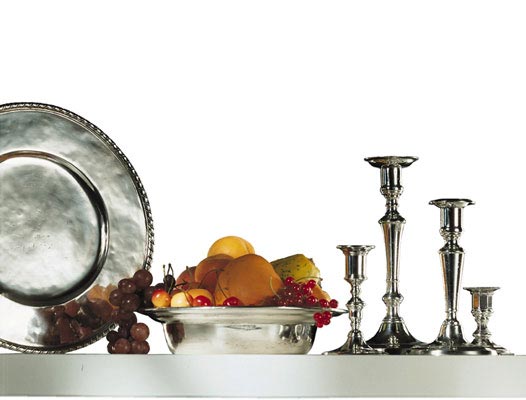Home
»
Om Selskapet
»
Historien om Tinn
Historien om Tinn
Ancient Times
Pewter, less expensive than silver, but just as striking and beautiful, is thought to have been first made in the Bronze Age, with bronze and pewter being related alloys. Pewter is mostly made up of tin, with a small amount of copper (and antimony), while bronze is mostly made of copper, with a small amount of tin. Metallurgists have speculated that pewter could have been invented when the quantities of metal in the alloy were reversed, either by accident or design.Pewter has been crafted into both useful and beautiful objects for at least the last 3 millennia; with references to be found in the Bible, ancient Egypt and the Roman Empire. Trade in tin can be traced back to the Phoenician times, followed by the Romans – in fact, it is thought that the availability of pewter's primary raw material, tin, in Britain, is what prompted Caesar to invade having followed early Phoenician trade routes. Tin is the fourth most precious metal today after platinum, gold and silver, and pewter has long been prized as an alternative to silver.
Early sources of tin in Europe came from Cornwall, Devon, Brittany and the Iberian Peninsula. Italy was also supplied with tin from Tuscany until Roman times, but, according to Pliny the Elder, tin mining was halted on the Italian peninsula in 80 AD by senatorial decree. The centre of the Italian pewter industry, Venice, imported its tin from the Middle East until the 15th Century, when cheaper sources of tin became available from Cornwall, which supplied the region until modern times.


From the Dark Ages through to Enlightenment
During the Dark and Middle ages, pewter production was limited due to conflicts throughout mainland Europe which curtailed tin production, and pewter was used primarily for religious iconography, but also by rich merchants and royalty. It is said that in 1290 AD, Edward I had over 300 pewter dishes, salts and platters, but no silverware! Later, especially by the Renaissance period, with increases in the overall standard of living as well as cultural enlightenment across Europe during the 14th -17th Centuries, pewter became important within the social and economic evolution of society, with pewter gradually replacing wood and clay as the mainstay materials for home-wares, such as plates and cutlery; pewter being a more durable material. Craft guilds developed throughout Europe during this time, regulating the quality of work by pewterers, including the Guild of Pewterers in Nuremberg, the Worshipful Company of Pewterers in England. Italy offered a very rich and varied landscape of experiences, beginning with the name of these institutions from city to city: Arts, Orders, Colleges, Scuoles or Fraglie in Venice, and Paratici in Brescia..
The Golden Age of Pewter
The 16th & 17th Centuries were the Golden Age of pewter, with pewter being the chief component of tableware and liturgical objects universally used across Europe, such as plates and candlesticks. The art of casting had become so sophisticated that truly beautiful pieces could be achieved, especially hollowware (tableware such as creamers, tea pots and tureens) coinciding with the craze, at that time, for new-fangled beverages, such as coffee & tea, as well as carafes and tankards, alongside the age-old staples of wine and ale. Pewterware became prized not just for its utilitarian purposes, but for its decorative beauty and as works of art.








